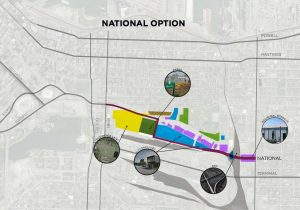When one word can possess a variety of meanings across different fields, it is important to provide accurate definitions for context. The word “arterial”, commonly used in the world of medicine, is also a word frequently used in construction and land development. My goal in this exercise is to provide knowledge of a word in a different light and to educate those pursuing interest in urbanization and the variety of ways to build up a society.
Chosen Term: Arterial
Parenthetical Definition: A through road.
Sentence Definition: An arterial is an urban road or throughway with a primary goal or function of delivering traffic, both vehicular and pedestrian, at the highest level of capacity and service possible. An arterial road can most likely be found between urban centres or highly populated areas, as well as leading commuters from city and suburban streets to multi-lane highways.
Expanded Definition:
An arterial in the field of land development is a high-capacity urban road. An arterial can be either a road, walkway, or throughway connecting people, both within and outside of vehicles, between urban centres and points of interest. They can also connect commuters from the streets of their homes and cities to large expressways.
Negation
An arterial, although sharing a similar purpose, cannot be coined as a freeway. It is not considered an expressway. This is because some arterial roads have occasional at-grade intersections, stop signs and traffic lights, or are simply too short in length to be considered an expressway.
What does an arterial road look like? How/when is it used?
An arterial road is used for fast and simplistic transportation. It provides a high level of service for the simplicity of its users. Pictured below is one of the three proposed arterial roadways for the city of Vancouver titled “The National Option” (credited to Daily Hive). You will notice how this specific proposed arterial road connects different urban centres with the overpass beginning at Chess Drive, cutting through Vancouver’s Fire Training Facility, and aligning with Grant Street to connect with Clark Drive, all while providing a safe path over the railway (Chan, 2018). The road provides a shortcut for commuters, providing them with a multitude of various stops along the way while keeping their overall travelling time shorter than what it originally would have been.

How does an arterial road differ from a local road?
In short, an arterial road differs from a local road in terms of its capacity to carry traffic. Arterial roads tend to have higher speed limits than local roads and have the main function of transporting people over long distances. In contrast, local roads serve primarily to provide access to various properties, such as businesses and houses and have a relatively minor role in carrying traffic compared to arterial roads (Toronto City Council, 2000).
Sources:
Chan, K. (2018, January 4). Vancouver’s new major arterial road through False Creek Flats could cost $230 million. Retrieved June 2, 2020, from https://dailyhive.com/vancouver/vancouver-new-arterial-road-false-creek-flats
City of Toronto road classification system as adopted by City Council, February 29, March 1 and 2, 2000, City of Toronto road classification system as adopted by City Council, February 29, March 1 and 2, 2000 (2000). Toronto, Ontario: City of Toronto, Works and Emergency Services Dept., Transportation Services Division, Transportation Programming and Policy Section, Operational Planning and Policy Unit.
The Government of British Columbia. (n.d.) Ministry of Transportation Authorities: Arterial Highways. Retrieved June 2, 2020, from https://www.th.gov.bc.ca/permits/Arterial Highways.asp
- Source used for further understanding of subcategories and classification of arterial roads.
Leave a Reply